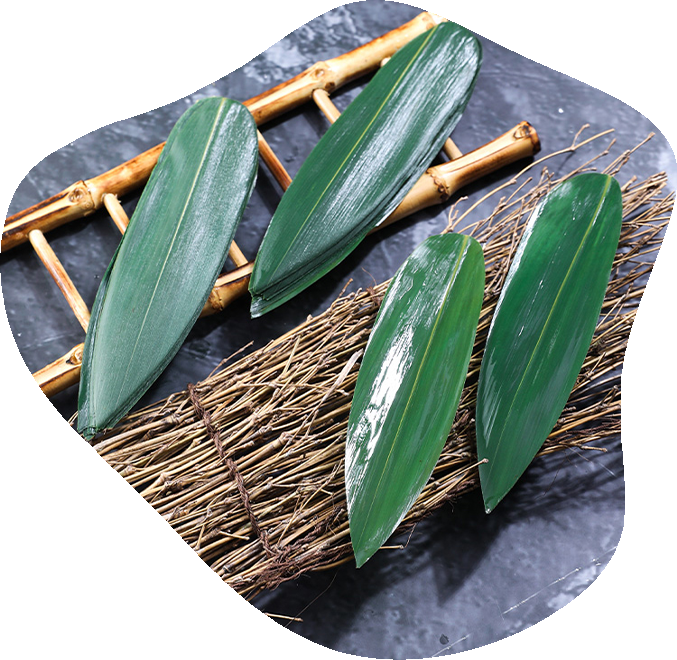Bamboo leaves are rich in silica flavonoids, amino acids, and phenolic, which can bring a ton of health benefits. Also, its properties make it an ideal choice for handicrafts and decorative purposes.
When processed, its leaves and shoots can be converted into medicinal products. Bamboo is also widely used for construction.

Bamboo leaves are medium to large in size and are long and lanceolate in shape tapering to a sight point opposite the stem end. The deep green leaves are tough, leathery, and smooth and are connected to green or brown stems that can grow up to ten centimeters a day. Typically, Bamboo leaves are harvested when they are no more than thirty centimeters in length and five centimeters in width, and they have a mild, sweet taste with faint notes of green tea. Dried bamboo leaves are used for wrapping Chinese dumplings. Dried bamboo leaves can be used for wrapping other foods too.
Boil briefly in water and soak overnight. Drain and press down with a heavy weight to prevent the leaves from curling.
Bamboo leaves grow on perennial evergreen plants belonging to the Gramineae or Gramineae family, and there are over a thousand different species of bamboo. Bamboo leaves come from many different species, with the most common species coming from China, including black bamboo, Phyllostachys nigra and moso bamboo, Phyllostachys edulis. A dwarf species called Kumaizasa or Sasa senanensis is also found in Japan. Bamboo leaves, also known as bamboo leaves or bamboos, are extremely versatile and can be used medicinally, to preserve or flavor food, or dried for making bamboo tea. In addition, bamboo leaves have been used for more than 1,000 years as a traditional Chinese medicine for the treatment of fever, detoxification, stomach heat, phlegm and hypertension.
Bamboo leaves contain protein, amino acids, potassium, calcium, manganese and iron. They also have a high polyphenol content and have antioxidant and antibacterial properties. In addition to aiding digestion, bamboo leaves are used to reduce inflammation and maintain body temperature. Vitamins that promote healthy hair are also found in bamboo. These vitamins include vitamin C, vitamin B and vitamin E. Bamboo shoots and leaves are used to treat stomach problems. They also help relieve intestinal worms and pain. Treatment of ulcers. When crushed and consumed in juice form, bamboo shoots can easily treat ulcers.
Bamboo leaves are not consumed, but used as wrapping paper or food containers. As wrapping paper, the leaves are used in dishes such as the glutinous rice dumplings known as zongzi in China. The rice is stuffed with fillings such as pork or mushrooms, wrapped in bamboo leaves, and then steamed; the leaves infuse the rice with the flavor of tea. Bamboo leaves are also used to wrap sasa-sushi (a type of sushi), and these bite-sized packages may contain a mixture of vegetables and fish on top of the rice. Bamboo leaves are common in sushi displays, and many sushi restaurants will use real bamboo leaves as decorative items in bento boxes. Fresh bamboo leaves are hard to find in stores They are perishable and only keep for a few days, but some specialty stores sell dried and pasteurized bamboo leaves. When purchased fresh, bamboo leaves should be immersed in a container of water and stored in the refrigerator for up to three days. Dried and pickled bamboo leaves can be kept for up to a year.
Bamboo leaves can also be used as a pot base for dishes such as rice cakes and meatloaf. To prepare bamboo leaves, boil them briefly in water and then soak them overnight. Drain and press down with a heavy object to prevent the leaves from curling.
Tea can be made from bamboo leaves and is very healthy and easy to prepare. Using the Australian Open Schedule, you will achieve your goals. Bamboo leaves contain silica, which promotes healthy hair, skin and nails. Silica also plays an important role in bone density, is a component of collagen, and prevents the absorption of aluminum in the digestive system. Bamboo contains 10 times more silica than horsetail, so it can be more effective in treating stronger, healthier hair and nails.
Place fresh bamboo leaves in boxes and freeze them quickly at specific temperatures, then thaw, sterilize and vacuum pack them in order to store the fresh leaves to always keep their fresh vibrant color and smell for a year. Soak the dried bamboo leaves in plenty of water for 5-6 hours until soft. 2 Wash the softened bamboo leaves with a dishwashing net or sponge, change the water and wash a 2nd time, then rinse thoroughly with water. 3 Drain and place in a zipper lock bag and refrigerate if using the next day.
Bundle the collected fresh bamboo leaves into bundles at certain intervals, place a certain number of bundles in a box, and then chill each box so that the fresh bamboo leaves are quickly frozen to the core. Frozen bamboo leaves are refrigerated at -15W-30°C per box. The bamboo leaves are then unfolded into each leaf and left to stand for 10w15hr for semi-thawing, then washed with water for complete thawing. Each thawed bamboo leaf was washed with cold water containing 0. 1W10ppm chlorine for sterilization. The resulting leaves are drenched with cold water, bagged in compartments and vacuum packed. The vacuum-packed bamboo leaves are refrigerated at -15W-25°C.
Copyright:@2020-2021
Comments Please sign in or sign up to post.
0
0 of 500 characters used